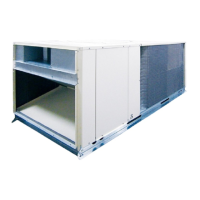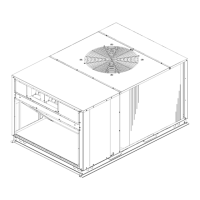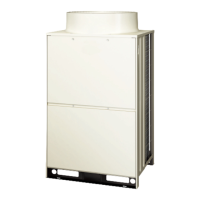Do you have a question about the Hitachi RUA-NP20ATS and is the answer not in the manual?
Lists specific models and specifies the refrigerant type (R410A) for the air conditioner.
Specifies the designed operating temperatures for the air conditioner for optimal performance.
Guides on how to start and stop the air conditioner unit correctly for safe operation.
Provides initial checks for common operational problems like no start or poor cooling.
Outlines basic maintenance tasks such as cleaning filters and condensers for upkeep.
Verifies required materials, location, space, and foundation for installation.
Instructions for transporting and positioning the unit safely and correctly.
Recommendations for connecting supply and return air ducts for optimal airflow.
Instructions for properly installing the condensate drain trap and piping.
Steps for connecting the main power supply to the unit's magnetic switch box.
Guidance on connecting control wires to the room thermostat and unit terminals.
Details PCB layout, DIP switch functions, power supply settings, and alarm detection.
Explains how to adjust the motor pulley to change the fan speed.
Provides tables for fan speed settings based on pulley adjustments.
Instructions on removing shipping washers to allow compressor floatation on isolators.
A checklist for verifying all installation steps before test running.
Steps for preparing gauges and setting the thermostat before initiating test runs.
Detailed sequence for running the unit and checking initial operation.
Guidance on compiling test running records for future reference and troubleshooting.
Details the settings for various safety and control devices like pressure switches and relays.
Procedures for inspecting and cleaning components like condensers, filters, and drain lines.
Guidelines for checking strainers and performing refrigerant re-charging with safety precautions.
Steps for preparing the unit for operation after a period of shutdown.
Advice on ordering replacement parts using the Hitachi Parts List.
Flowcharts for diagnosing issues when the unit is not cooling or the fan motor is faulty.
Diagnosing insufficient cooling, high discharge pressure, and low discharge pressure.
Identifying and resolving causes for high/low suction pressure and noisy operation.
Lists specific models and specifies the refrigerant type (R410A) for the air conditioner.
Specifies the designed operating temperatures for the air conditioner for optimal performance.
Guides on how to start and stop the air conditioner unit correctly for safe operation.
Provides initial checks for common operational problems like no start or poor cooling.
Outlines basic maintenance tasks such as cleaning filters and condensers for upkeep.
Verifies required materials, location, space, and foundation for installation.
Instructions for transporting and positioning the unit safely and correctly.
Recommendations for connecting supply and return air ducts for optimal airflow.
Instructions for properly installing the condensate drain trap and piping.
Steps for connecting the main power supply to the unit's magnetic switch box.
Guidance on connecting control wires to the room thermostat and unit terminals.
Details PCB layout, DIP switch functions, power supply settings, and alarm detection.
Explains how to adjust the motor pulley to change the fan speed.
Provides tables for fan speed settings based on pulley adjustments.
Instructions on removing shipping washers to allow compressor floatation on isolators.
A checklist for verifying all installation steps before test running.
Steps for preparing gauges and setting the thermostat before initiating test runs.
Detailed sequence for running the unit and checking initial operation.
Guidance on compiling test running records for future reference and troubleshooting.
Details the settings for various safety and control devices like pressure switches and relays.
Procedures for inspecting and cleaning components like condensers, filters, and drain lines.
Guidelines for checking strainers and performing refrigerant re-charging with safety precautions.
Steps for preparing the unit for operation after a period of shutdown.
Advice on ordering replacement parts using the Hitachi Parts List.
Flowcharts for diagnosing issues when the unit is not cooling or the fan motor is faulty.
Diagnosing insufficient cooling, high discharge pressure, and low discharge pressure.
Identifying and resolving causes for high/low suction pressure and noisy operation.
| Brand | Hitachi |
|---|---|
| Model | RUA-NP20ATS |
| Category | Air Conditioner |
| Language | English |












